|
Just like with the old commercial
jingle that went,  "Everybody doesn't
like something, but nobody doesn't like
Sara Lee," I can pretty
confidently substitute "seaplanes" for "Sara Lee." The Grumman Widgeon was one of
many iterations of their twin engined amphibious airplanes that is immediately recognizable
to most people over the age of 40. In fact, the Widgeon was the seaplane that appeared
each week on the 1970s television show "Fantasy Island." It
was "Ze plane! Ze plane!" that Tattoo would call out at the beginning of each episode.
The Marh 1967 issue of American Aircraft Modeler magazine carried a nice article
on the Grumman Widgeon's history, along with a fine set of 3-view drawings by
Paul R. Matt. "Everybody doesn't
like something, but nobody doesn't like
Sara Lee," I can pretty
confidently substitute "seaplanes" for "Sara Lee." The Grumman Widgeon was one of
many iterations of their twin engined amphibious airplanes that is immediately recognizable
to most people over the age of 40. In fact, the Widgeon was the seaplane that appeared
each week on the 1970s television show "Fantasy Island." It
was "Ze plane! Ze plane!" that Tattoo would call out at the beginning of each episode.
The Marh 1967 issue of American Aircraft Modeler magazine carried a nice article
on the Grumman Widgeon's history, along with a fine set of 3-view drawings by
Paul R. Matt.
Grumman Widgeon 3-View
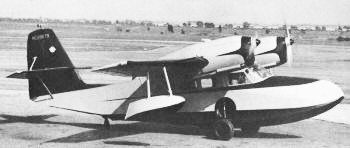
The G-44A Widgeon with two inverted Fairchild Rangers and Sensenich wood props
with bullet-nose spinners.
Authentic plans and data on an all-time modeling favorite. Simple squared-off
wings and tail surfaces, flat sided fuselage, in-line engines make for easy construction
of a beautiful and stable model.
It was in the late 1930's that the Grumman Aircraft Engineering Corp. of Bethpage,
Long Island produced their first civil or commercial type aircraft. This, Grumman's
design 21A, was called "Gray Goose"; later it would be generally known simply as
the "Goose". The powerful amphibian gained wide acceptance by numerous business
enterprises, well-to-do private flyers as well as the military services. In spite
of this, Grumman recognized that the market for this type of amphibian would be
limited. Shortly thereafter plans were laid out for an immediate successor. It was
the aim to produce a smaller commercial and utility amphibian which would fill a
void in this category and lucrative market through a reduction in initial cost,
lower operating expenditures and a more simplified over-all design,
Mother-"Goose" had her first offspring in 1940 when the baby amphibian, model
G-44, was hatched. In July of that year the newborn black and yellow prototype,
NX28633 made her maiden flight and, of course, mother-goose was quite proud of her.
She was christened the "Widgeon" shortly after leaving the nest, spreading her wings
and flying straight and true for a 20-minute first flight.
Of all-metal construction except for fabric-covered control surfaces and aft
portions of the outer wing panels, the aircraft provided unequalled utility and
rugged characteristics for its class and category ($30,000 price bracket). Power
was supplied by two inverted six-cylinder air cooled Fairchild "Ranger" 6-440C-5
engines, of 200 hp at 2450 rpm (sea level rating). Top speed at optimum altitude
was 165 mph and cruising speed 150 mph, somewhat optimistic figures as more pilots
reported 150 mph tops and. a reasonable cruising speed of 138 mph. The Widgeon was
no slouch in the air; it climbed at 105 mph with 12 degrees flaps; after final approach,
with 40 degrees flaps, settled in at 75 mph, touching down around 60/65 mph. There
was complete control throughout the speed range; ailerons, rudder and elevators
were responsive up to and through a full stall. It could be trimmed to fly hands-off
and turned into one dead engine in complete safety with aileron control alone. There
was never any claim that the Widgeon could hold its altitude on one engine, however,
but the safety factors inherent in such a design provided less worry and trouble
should one engine be lost.
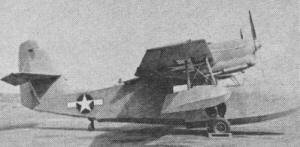
Coast Guard J4F-1 of WW-2 period. Two-tone color scheme: blue plan-view and side
surfaces, white on all undersurfaces.
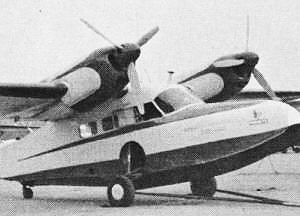
Super-Widgeon conversion by McKinnon-Hickman, using Lycoming flat-sixes and three-bladed
controllable-pitch props.
Excellent flying characteristics is one matter with an aircraft-control on land
is another, while water performance is still another. Control on land was easy with
no ground looping tendency, visibility was good, brakes and the steerable tail wheel
along with the capability of "jockeying" engines provided unexcelled maneuvering.
On water there was no porpoising, no problems with cross-wind landings and it operated
well from calm seas to two foot swells. It was designed to withstand rougher seas
without undue strain but this was not a recommended procedure.
The success of the rugged little Widgeon brought immediate orders and within
a year of the prototype's first flight, 16 were ordered by private interests. One
of the machines was demonstrated to the U.S. Navy and, impressed by the possibilities
of such a versatile craft, it ordered eight machines as the J4F-1 for delivery and
service with the U.S. Coast Guard. These were delivered in 1941. An additional order
followed as war clouds loomed ever closer that year and the Coast Guard took delivery
of an additional 17 JF4-1's in 1942.
The Widgeon had little chance to prove its ability and usefulness in private
hands prior to the United States entry into World War II. By the latter part of
1941, the military services were hard pressed for all types of aircraft. The Navy
in particular, long denied sufficient funds to build up an adequate air arm, suddenly
found itself in dire need of everything from a top rated front line fighter to utility
types and short range search and rescue aircraft. With additional funds available
the Navy sought the Widgeon as a valuable asset. During those hectic mid-1940 war
years the Grumman Corp. was busy with fighter and torpedo bomber orders but managed
to supply 131 Widgeons to the Navy as J4F-2's.
The Army Air Corps, given priority during the early war years, impressed what
appears to have been all 44 pre-war civil models as their model OA-14's by 1942.
In 1944, the Navy released several J4F-2's to the Brazilian Navy where they assumed
utility and off-shore patrol duty in much the same manner as those used by the U.S.
Navy. An additional 15 J4F-2's were supplied to the Royal Navy for communications
duty and were renamed by the British - the "Gosling" I. Majority of the Goslings
served in the West Indies during World War II.
Assigned off-shore patrol duties and anti-submarine patrol early in the war,
the Coast Guard experimented with the use of depth charges on their J4F-1's. America
was at war and the Coast Guard didn't particularly care to fly over submarine infested
waters without some sort of defensive weapon. Special racks were installed under
each wing root, midway between the fuselage and engines. The Widgeons proved adaptable
to this new role and still carryall the usual Naval navigation, radio and survival
gear, plus pilot, co-pilot and radio operator. Tests were made and a number of trial
runs with the bomb laden J4F's but the need for short range anti-submarine bombers,
such as several of the Widgeons were converted into, dwindled by 1944 and little
opportunity arose to prove their capabilities in this role.
One J4F-1 Widgeon did go down in the pages of history. The author had the opportunity
of making a number of flights in this particular machine although not on the particular
recorded flight. On August 1, 1942 the single Widgeon assigned to Coast Guard Squadron
212 based at Houma, Louisiana N.A.S. scored a direct hit with its depth charges
on the German submarine U-166 just off the mouth of the Mississippi River near New
Orleans. This was the first "kill" of an enemy submarine by the Coast Guard and
the sinking of the U-166 is officially credited to the lone Widgeon out of Houma.
(Houma was both a LTA and HTA Naval Air Station. Its primary function was anti-submarine
patrol in the north central Caribbean area. During 1942 and '45 there were five
K type blimps assigned as well as several Navy and Coast Guard aircraft ranging
from PBY-5A's to Beech GB-2 Staggerwings.)
Production of military versions of the G-44 was completed in 1945. Before the
war's end, the Government permitted Grumman to deliver (to certain high-priority
firms) an improved civil version model C-44A. Hull was modified, main step moved
forward a few inches, a deeper keel-line forward, and an improved breather system
employed to enable easier "unsticking" and for better water handling. Customers
were found for about 75 post-war Widgeons before manufacturing rights were sold
to French Societe de Constructions Aeros-Navales in 1949 to build Widgeons in France
as SCAN-30.
The French concern made only minor modifications to the airframe, the major change
coming with the installation of 200 hp Salmson 8 AS-00 engines. Performance-wise
there was little difference or improvement over its predecessors. Some 40 SCAN-30's
were built but the European market for the aircraft failed to materialize. Thirty
completed airframes were exported back to the United States for further conversions
by other independent manufacturers. These machines, less engines, were purchased
by several concerns in the United States.
A number of Grumman Widgeons as well as a few SCAN-30's were modernized, converted
and in some respects modified to Super Widgeons by the McKinnon-Hickman Co. These
models were re-engined with 260 hp Lycoming GO-435A flat-six engines. Overwing exhaust
added augmented thrust while new Hartzell three-bladed controllable pitch propellers,
of smaller diameter than previously used, gave added performance and prolonged the
life of the basic design concept. By late 1954 29 McKinnon-Hickman conversions were
sold.

"Petulant Porpoise," 12.5 to 1 hull, among tests in cooperation with Navy and
NACA.
Still the Widgeon refused to fly off into the sunset. Some 15 existing SCAN-30
models were rounded up for another conversion possibility, when in 1959 the Pacific
Aircraft Engineering Corp. modified one into a rather impressive but expensive "complete
package" version called the PAGE "Gannet". What seemed enormous Lycoming R-680-E3
300 hp radial engines were fitted along with 34 other major refinements to the little
Wigeon's airframe. The Gannets were sold as luxury, complete communication/navigation,
executive aircraft priced at $89,950 complete. They sported all-metal wings, new
wing ribs, six watertight compartments in the hull, instead of the original three,
flush riveting, better performance and a greater payload. They were resplendent
even to chrome-plated engine cylinders.
One of the more interesting projects in which a Widgeon (J4F-2) was involved
was its utilization to test increased hydrodynamic and aerodynamic elongated flying
boat hulls. The Navy, in cooperation with the NACA, sponsored water and flight tests
in which the entire lower hull of the J4F-2 was cut away and various newly designed
hulls of high length to beam ratios were tested. The Edo Float Corp. undertook the
initial trials at College Point, L.I. shortly after WW II. The purpose was to test
proposed hulls for larger flying boats then in the design stages, such as the P5M
"Marlin" and P6M "Seamaster". Various hulls could be removed and different ones
bolted on. One hull had a length/beam ratio of 12.5 to 1 and was successfully tested
in the air and on the water with the Widgeon nicknamed the "Petulant Porpoise."
Certainly the Widgeon had a long, varied and interesting life. Once off the drawing
board it didn't take long to mature. From the pre-WW II $30,000 G-44 to the $30,600
post-war model G-44A, the basic airframe proved capable of accepting many alterations,
conversions and a variety of power plants. Significantly enough even with the latest
Gannet version with 600 hp and almost triple its original price tag, the original
airframe design and construction remained unaltered except for those changes dictated
by the "modern trend". Even to this day, some 26 years after the original Widgeon
left her nest, a great many G-44's still push their prognathous snouts through seas
and sky all over the world.
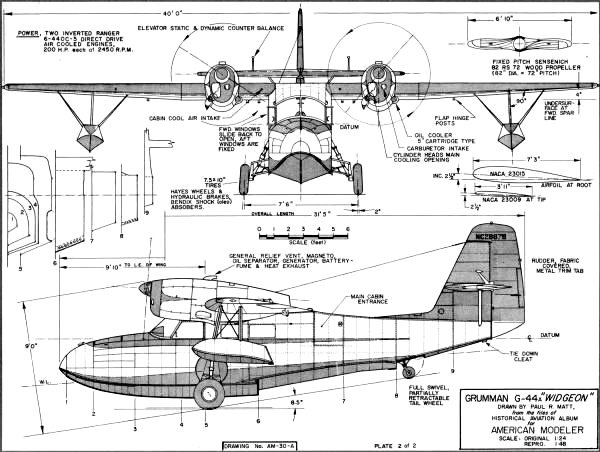
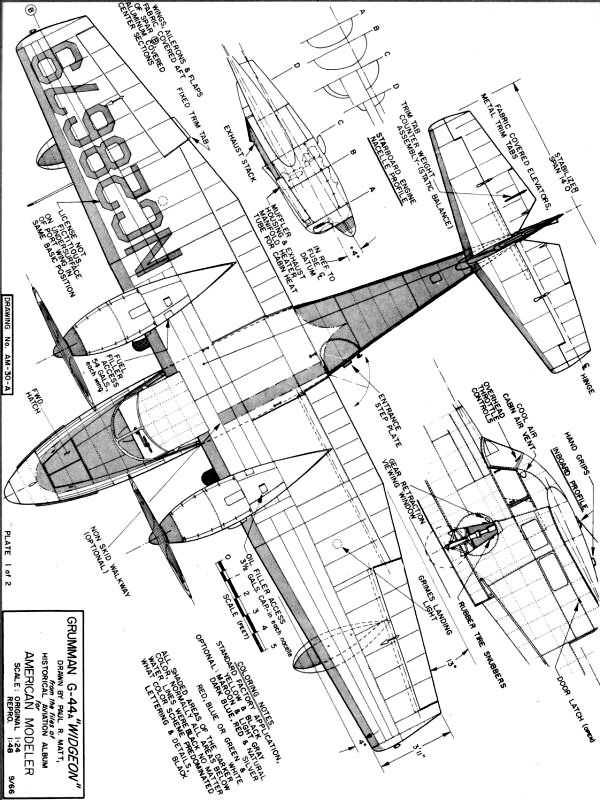
Notice:
The AMA Plans Service offers a
full-size version of many of the plans show here at a very reasonable cost. They
will scale the plans any size for you. It is always best to buy printed plans because
my scanner versions often have distortions that can cause parts to fit poorly. Purchasing
plans also help to support the operation of the
Academy of Model Aeronautics - the #1
advocate for model aviation throughout the world. If the AMA no longer has this
plan on file, I will be glad to send you my higher resolution version.
Try my Scale Calculator for
Model Airplane Plans.
Here are a couple photos I took of the Grumman G-21 Goose, at the Udvar-Hazy Center
of the National Air & Space Museum.
 
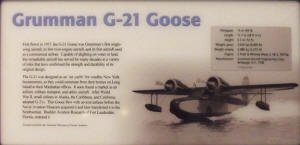
Posted January 31, 2024
(updated from original
post on 9/20/2014)
|